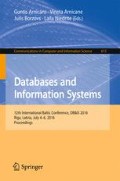Abstract
In this paper, we propose an experimental tool for analysis and graphical representation of glossaries. The original heuristic algorithms and analysis methods incorporated into the tool appeared to be useful to improve the quality of the glossaries. The tool was used for analysis of ISTQB Standard Glossary of Terms Used in Software Testing. There are instances of problems found in ISTQB glossary related to its consistency, completeness, and correctness described in the paper.
Access this chapter
Tax calculation will be finalised at checkout
Purchases are for personal use only
References
Arnicane, V., Arnicans, G., Borzovs, J.: Improvement of systematic collection of terminology. http://science.df.lu.lv/aab16
Arnicans, G., Romans, D., Straujums, U.: Semi-automatic generation of a software testing lightweight ontology from a glossary based on the ONTO6 methodology. In: Caplinskas, A., et al. (eds.) Databases and Information Systems VII. Frontiers in Artificial Intelligence and Applications, vol. 249, pp. 263–276. IOS Press, Amsterdam (2013)
Arnicans, G., Straujums, U.: Transformation of the software testing glossary into a browsable concept map. In: Sobh, T., Elleithy, K. (eds.) Innovations and Advances in Computing, Informatics, Systems Sciences, Networking and Engineering. LNEE, vol. 313, pp. 349–356. Springer International Publishing, Switzerland (2015). doi:10.1007/978-3-319-06773-5_47
Deokattey, S., Bhanumurthy, K.: Domain visualisation using concept maps: a case study. DESIDOC J. Libr. Inf. Technol. 33(4), 295–299 (2013)
Hilera, J.R., Pagés, C., Martínez, J.J., Gutiérrez, J.A., De-Marcos, L.: An evolutive process to convert glossaries into ontologies. Inf. Technol. Libr. 29(4), 195–204 (2010)
ISTQB: Certifying software testers worldwide. http://www.istqb.org/
ISTQB: Standard glossary of terms used in software testing. http://www.istqb.org/downloads/category/20-istqb-glossary.html
Kuļešovs, I., Arnicane, V., Arnicans, G., Borzovs, J.: Inventory of testing ideas and structuring of testing terms. Baltic J. Mod. Comput. 1(3–4), 210–227 (2013)
Manning, C.D., Surdeanu, M., Bauer, J., Finkel, J.R., Bethard, S., McClosky, D.: The Stanford CoreNLP natural language processing toolkit. In: ACL (System Demonstrations), pp. 55–60 (2014)
Medelyan, O., Witten, I.H., Divoli, A., Broekstra, J.: Automatic construction of lexicons, taxonomies, ontologies, and other knowledge structures. Wiley Interdisc. Rev. Data Min. Knowl. Disc. 3(4), 257–279 (2013)
Navigli, R.: Using cycles and quasi-cycles to disambiguate dictionary glosses. In: Proceedings of the 12th Conference of the European Chapter of the Association for Computational Linguistics, pp. 594–602. Association for Computational Linguistics (2009)
Navigli, R., Velardi, P.: Ontology enrichment through automatic semantic annotation of on-line glossaries. In: Staab, S., Svátek, V. (eds.) EKAW 2006. LNCS (LNAI), vol. 4248, pp. 126–140. Springer, Heidelberg (2006)
Navigli, R., Velardi, P.: From glossaries to ontologies: extracting semantic structure from textual definitions. In: Ontology Learning and Population: Bridging the Gap Between Text and Knowledge, pp. 71–87 (2008)
Nuopponen, A.: Tangled web of concept relations. concept relations for ISO 1087–1 and ISO 704. In: Terminology and Knowledge Engineering 2014, pp. 10-p (2014)
Velardi, P., Faralli, S., Navigli, R.: Ontolearn reloaded: a graph-based algorithm for taxonomy induction. Comput. Linguist. 39(3), 665–707 (2013)
Acknowledgments
This paper partially has been supported by the European Regional Development Fund Project No. 2DP/2.1.1.3.1/11/APIA/VIAA/010.
Author information
Authors and Affiliations
Corresponding author
Editor information
Editors and Affiliations
Rights and permissions
Copyright information
© 2016 Springer International Publishing Switzerland
About this paper
Cite this paper
Arnicane, V., Arnicans, G., Borzovs, J. (2016). Heuristic Method to Improve Systematic Collection of Terminology. In: Arnicans, G., Arnicane, V., Borzovs, J., Niedrite, L. (eds) Databases and Information Systems. DB&IS 2016. Communications in Computer and Information Science, vol 615. Springer, Cham. https://doi.org/10.1007/978-3-319-40180-5_23
Download citation
DOI: https://doi.org/10.1007/978-3-319-40180-5_23
Published:
Publisher Name: Springer, Cham
Print ISBN: 978-3-319-40179-9
Online ISBN: 978-3-319-40180-5
eBook Packages: Computer ScienceComputer Science (R0)

